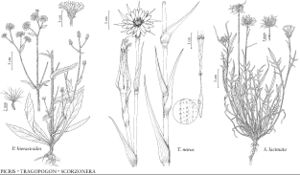Scorzonera
Sp. Pl. 2: 790. 1753.
Gen. Pl. ed. 5, 346. 1754.
| Taxon | Illustrator ⠉ | |
|---|---|---|
 | Picris hieracioides Tragopogon mirus Scorzonera laciniata | Marjorie C. Leggitt Yevonn Wilson-Ramsey Marjorie C. Leggitt |
Annuals, biennials, or perennials [subshrubs], 5–100+ cm; taprooted. Stems 1, erect, branched from bases and/or distally, glabrous or hairy. Leaves basal and cauline; basal sessile or petiolate, distal sessile; blades ovatelanceolate to lanceolate or linear, margins entire or pinnately lobed to pinnatisect (faces glabrous or ± arachnose [tomentose]). Heads borne singly or in loose, corymbiform arrays. Peduncles not inflated, sometimes bracteate. Calyculi 0. Involucres ovoid to cylindric, 6–12 [–16+] mm diam. (larger in fruit). Phyllaries 18–30+ in 3–5+ series, deltate or ovate to lanceolate or lance-linear (± flat proximally, not enfolding subtended florets), unequal, margins scarious, apices obtuse to acute. Receptacles flat, pitted, glabrous, epaleate. Florets 30–100+; corollas whitish to yellow or purplish. Cypselae whitish to brownish, narrowly columnar to obclavate or fusiform (sometimes ± stipitate), not beaked, nerves usually 10, sometimes 0, faces mostly glabrous, sometimes distally villosulous [lanate]; pappi persistent, of 28–50+, whitish, subequal, plumose to barbellate, subulate to setiform scales in 2–3 series. x = 7.
Distribution
Introduced; Europe, Asia
Discussion
Species ca. 175 (2 in the flora).
Selected References
None.
Lower Taxa
Key
| 1 | Leaf blades 70–200 × (5–)20–40 mm, margins of the basal usually pinnately lobed | Scorzonera laciniata |
| 1 | Leaf blades 120–400 × (1–)3–6 mm, margins entire (flat or undulate) | Scorzonera hispanica |
"fine" is not a number.